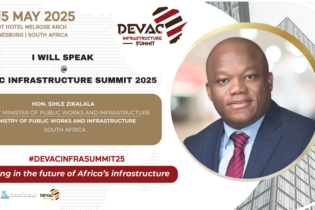The South African Institution of Civil Engineering (SAICE) inaugurated its 111th president at the SAICE Presidential Inauguration and Gala Dinner at Montecasino in Johannesburg on 12 February 2013.
The event, attended by various high-profile guests, including environmental professionals, champions of the infrastructure industry, government officials, engineering clients from both the private and public sectors, as well as SAICE members were challenged by the very interesting views expressed in Peter Kleynhans’ address titled Reflections and Future. He shares his views formed through decades of working in the civil engineering industry and how these views could illustrate what is needed going forward. He discusses long-term adaptations which require behavioural and attitudinal changes necessary to arrest environmental change, globalisation and increase in consumption. Much of what Kleynhans is saying will not please and could be unpopular in certain spheres. He mentions some interesting statistics, among other, that around a third of the world’s population is reported to live in poverty (more than two billion people). In Africa it is thought to be about three hundred million. “Unemployment is a global phenomenon. This state of affairs might indicate that the global economy is unable to provide employment for the world’s population.” On population growth, Kleynhans states, “We need to actively promote and support appropriate initiatives to attain a continuous reduction in the population growth rate. Such interventions are in the interest of both current and future generations.” On demand management, he explains that while measures have been put in place to reduce the impact of civil engineering works on the environment, what has not received attention is reducing the need for engineering works. “The clamour for new works to satisfy the existing and burgeoning population has enabled us (civil engineers) to fulfil our aspirations (creating immovable assets). On the other hand, this is being achieved at the expense of future generations. Also, each new immovable asset creates a life-long liability. “A case can be made, therefore, that the demand for immovable assets should be reduced. The consequence of such an approach is that, at the outset of any civil engineering project, the question should be asked as to whether or not the immovable asset is really necessary. Only if the answer is truly positive should a project proceed in the most environmentally effective manner.”He asserts that “Engineering, particularly civil engineering, has done very much to benefit humankind over the centuries and to increase standards of living. Indeed, we pride ourselves on applying the skill, art and science of our calling to the benefit of humankind and to adapting nature to that end. The unintended outcome of our endeavours, is that we have played a major role in enabling unbridled population growth, increasing demand and resource degradation/depletion to occur.
“We have a mind-set that a growing population is necessary for our industry and economies to flourish. This view is open to question. A large, significantly impoverished population is not conducive to business or economic growth. Povertology (the process of making a living out of poverty) is far more limiting than is the opportunity to develop businesses in a smaller, but better-off society. Impoverishment tends to drain economies, rather than add to economic stability and growth,” argues Kleynhans. He continues, “Engineering skills have not been and are not being adequately viewed as a national asset. Engineering practitioners are developed at great expense over a lengthy period, generally at least three decades. Due to historical attitudes these assets are then ‘retired’ before many of them have completed their useful lives. Coupled with this is increasing life-expectancy, which results in engineering practitioners being ‘fit for purpose’ for much longer than in the past. Retirement is becoming an antiquated concept and we need to adjust our attitudes, as well as the utilisation of ‘engineering practitioner assets’, accordingly.” This truly thought-provoking presidential address, in essence, provides a ‘blueprint’ of how South Africa could change much of the issues which currently seem insurmountable. The 2013 SAICE Civilution CongressThis congress will be held at the end of September and will address many of the issues facing civil engineering, including those raised in Kleynhans’s address. He says, “These are contentious and there will be very divergent views and disparate aspirations. Also, much that is required will take the civil engineering industry out of its comfort zones and could be perceived as being against the self-interest, thereby requiring a CIVILUTION.” The Congress aims to create an engineering revolution for evolution towards solutions in developing, maintaining and enhancing civilisation and more specifically southern African civilisation. Background
Peter is a registered professional engineer, professional planner, professional construction project manager and a chartered engineer with broad-ranging experience spanning more than 40 years. He is a Fellow of SAICE, as well as a Fellow or Corporate Member of five other professional institutions in South Africa and in the United Kingdom. Key experience
In addition to the technical fields of engineering planning, design and construction management, and physical (town and regional) planning, his experience includes strategic and business planning, people management, coordination of professional services, marketing and directing the execution of projects. Project work has included the provision of services to clients and communities in the fields of urban and rural development, town and regional planning, capacity building, facilitation, environmental management, water and sanitation services, streets and stormwater drainage, water services development plans, by-laws and infrastructure planning models, as well as management support to central government, regional authorities and municipalities. Association with SAICE
Over more than 30 years Peter has served on several SAICE divisional committees, and was chairman of the Institution’s Finance and Administration Committee. He is a member of the SAICE Council and has served on the Executive Board in various capacities. Peter received the SAICE President’s Award in 2002 for meritorious service to SAICE and for significant ongoing contributions towards the civil engineering profession. In 2009 he received the SAICE President’s Award for exceptional voluntary service to SAICE.








